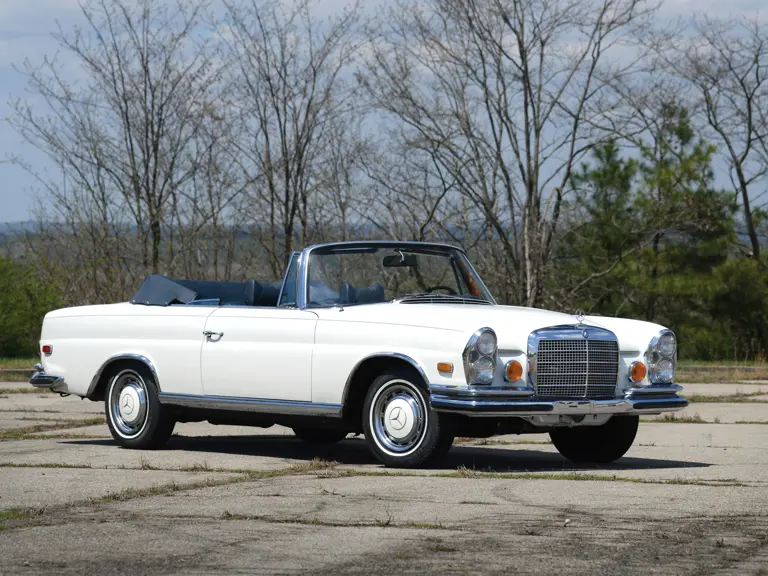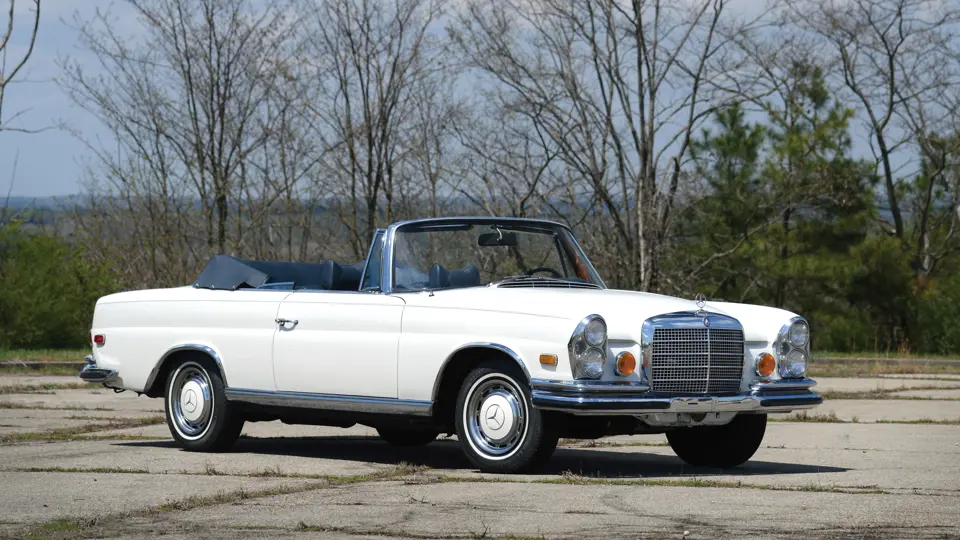Mercedes’ W108 and 109 models were the large luxury line of 1965–1972, replacing the Heckflosse or “Fintail” W111/112 cars. They initially used the venerable overhead-cam straight six in several sizes. A 2,778-cubic centimeter “M13” engine in 1967 gave rise to 280S and 280SE model designations. By 1969, however, it was recognized that the lack of a V-8 was a limitation in the U.S. market, so a 3.5-liter powerplant, designated M116, was developed.
Using a cast iron block for rigidity, economy, and better sound damping, it had cross-flow wedge cylinder heads with rocker-operated valves driven by a single overhead camshaft per bank. Cams were chain-driven for a long life. Bosch transistorized the ignition, and electronic fuel injection was utilized. The British magazine AutoCar called it “a copybook example of how experience plus careful design can create a simple-to-make high output engine of considerable refinement.” Initially with 3,499-cubic centimeter displacement, it was followed by a 4,520-cubic centimeter “big-block” M117 version in 1971.
Mercedes-Benz’s second V-8, after their mighty 6.3, was a “hot rod” engine. Just as with a small-block American V-8, the compact, fuel-injected, 3.5-liter unit would fit under the hood, where a straight six would have previously been the top offering. The new 280SE Cabriolet looked like the six-cylinder 280, but it had big, reliable power from the new engine to propel it into the 1970s and to 60-mph in under 10 seconds, with a 130-mph top speed behind its 230 horsepower. This wasn’t musclecar territory, but it was highly respectable for a full-on luxury cabriolet weighing over 3,600 pounds. The high-revving engine displaced only 213.5 cubic inches, and so, it blew through the one-horsepower-per-cubic-inch barrier.
In Mercedes’ sometimes confusing nomenclature, the new W108 model was designated 280SE 3.5, to distinguish it from its six-cylinder counterpart. Production began in August 1969 and continued through July 1971. Total production in 24 months was the very modest number of 3,270 coupes and 1,232 cabriolets.
Hand-crafted to exacting standards; this Mercedes-Benz-built model was what many qualified people believed was the finest automobile in the world, and 1971 was the only year that this model (802 vehicles) was imported into the United States. For the buyers who wanted wind in their hair, there was no finer choice than the 280SE 3.5 Cabriolet, which was the fastest, most sumptuous, and most expensive convertible that money could buy at a Mercedes-Benz dealership. It was a car that appeals, then as now, to great enthusiasts.
No American car of the era could match the new Mercedes’ mix of technology and quality. Fully-independent coil-spring suspension and four-wheel disc brakes meant that ride and handling with the long-wheelbase chassis were thoroughly modern; but unlike a car of the 21st century, the look was completely distinctive and completely Mercedes-Benz, or “fabulously handsome,” as Road & Track called it. While the rear seats are larger than those of previous models, they were of the occasional variety. Front passengers, however, were treated to the level of the understated elegance that one would expect in a car of this caliber, and price.
The White example being offered is a four-owner car that is sophisticated and classy with its lines beautifully expressed with a navy blue top, top boot and interior. The 280SE is equipped with a pair of classic leather Mercedes semi-bucket seats that are comfortable for any driving in any conditions. They face a leather-wrapped, wood-faced two-dial dashboard. The large register vents confirm this car is equipped with air conditioning, making it even more attractive, as it can be driven year-round. The Mercedes-Benz is further equipped with a four-speed automatic transmission, Becker radio with power antenna, removable center console seat pad, dashboard clock; power windows, top, steering and four-wheel disc brakes.
Further attributes found with this 280SE includes a “spotless” engine compartment and undercarriage; it has straight bodywork all-around and the interior projects slight patina. The current owner has never had any issues that needed major repair. The top and interior have been replaced, while the paint is reported as being thought to be original. Additional interest is to be gained by the car being accompanied by 35-years of service records (primarily the past 20), leather boot bag, first aid kit, tool roll, plus the factory build sheet, all sales booklets and service manuals.
The 3.5 was a rocket ship, and has continued to gain even more respect as the years have passed. As Car & Driver said in 1970, after an experience on Nevada’s Interstate 80, then without a speed limit, “You’d have to say that sustained high speeds are just about the name of the game with the Mercedes-Benz...the car never gave any indication that it was doing anything strenuous.” With peak power output at 6,500-rpm and an observed top speed of 122-mph, it was developed to handle both lead-footed Americans and unrestricted autobahn (or Nevada) highways.
These driving experiences also could be found in searching out the most scenic stretch of coastline, a landscape of towering bluffs, pastel-hued villages terraced into hillsides, precipitous corniche roads, luxuriant gardens, or expansive vistas over turquoise waters and green-swathed mountains. This model was most at home in some of the most respected addresses on the planet when new and is embraced in these locales to this day.



 | Auburn, Indiana
| Auburn, Indiana


